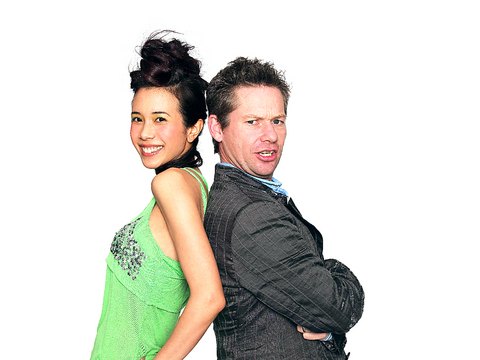Ian Wright, the Globe Trekker host on Discovery Travel and Living Channel, visited Taiwan earlier this week.
He has visited Taiwan on four previous occasions. Wright said he loves Taiwan's people, and judging by the popularity of the Lonely Planet programs that he hosts, those feelings are reciprocated.
"I was so surprised that so many people in Taiwan watch the show. Last time I was in a market, every five steps, people would call out to me. I'm a rock star here," Wirght said arching his eyebrow. "You're mad, absolutely, but I love you."

PHOTO COURTESY OF DISCOVERY CHANNEL
The backpacker host came to Taiwan last weekend to promote a new program, which is of a completely different ilk from those he has been doing for the past 12 years. Taking off his trademark slop jacket, he showed off a fine designer suit. After visiting Taiwan, Wright jetted off to Hong Kong to meet celebrity Karen Mok (
Has the tux changed Ian Wright in any way? "Suits are still like fancy things to me. I am not a different person. It's almost like an interesting experiment. It's just like I'm going to another world."
In the first episode, Wright barges into Karen Mok's life. He crashes her fashion shoot, hijacks her karaoke booth, plays the voice of an animated animal in a movie, eats her pudding and fights her trainer. How does he get away with such antics?
"Most of the time, everyone's there with the same purpose, and you've talked to people before you go on anyway. Everyone knows it is fun," he said, "I never ever use personal attacks, I try not to do that, it's too easy, but it's not fun."
Before becoming a TV presenter, Wright had traveled through Egypt for a couple of months, Nepal and India for seven months, Guyana for three months, hitchhiked though Ireland, and gone all around Europe.
Wright said traveling was an amazing lifestyle, but being away from home for seven months a year, he wishes he could spend more time in London. "It's not fun being left, doing hard work, doing all the laundry alone," he said.
The jovial Englishman believes that spending too much time pondering the imponderables of philosophy detracts from life's rich experiences. "Things come. Keep looking, meet different people, and exchange ideas. There is no rule," he said.
The globe trotter never worries about his backpack. "There is no secret, there is nothing mysterious about a rucksack. All you need is money, passport, a change of clothes, and forget the rest," he said.
"I never travel without my sketch book," said Wright, a long-time painting enthusiast. Though he doesn't think too much before hitting the road, on returning home he likes to reflect on his travels.

Oct. 27 to Nov. 2 Over a breakfast of soymilk and fried dough costing less than NT$400, seven officials and engineers agreed on a NT$400 million plan — unaware that it would mark the beginning of Taiwan’s semiconductor empire. It was a cold February morning in 1974. Gathered at the unassuming shop were Economics minister Sun Yun-hsuan (孫運璿), director-general of Transportation and Communications Kao Yu-shu (高玉樹), Industrial Technology Research Institute (ITRI) president Wang Chao-chen (王兆振), Telecommunications Laboratories director Kang Pao-huang (康寶煌), Executive Yuan secretary-general Fei Hua (費驊), director-general of Telecommunications Fang Hsien-chi (方賢齊) and Radio Corporation of America (RCA) Laboratories director Pan
The consensus on the Chinese Nationalist Party (KMT) chair race is that Cheng Li-wun (鄭麗文) ran a populist, ideological back-to-basics campaign and soundly defeated former Taipei mayor Hau Lung-bin (郝龍斌), the candidate backed by the big institutional players. Cheng tapped into a wave of popular enthusiasm within the KMT, while the institutional players’ get-out-the-vote abilities fell flat, suggesting their power has weakened significantly. Yet, a closer look at the race paints a more complicated picture, raising questions about some analysts’ conclusions, including my own. TURNOUT Here is a surprising statistic: Turnout was 130,678, or 39.46 percent of the 331,145 eligible party

The classic warmth of a good old-fashioned izakaya beckons you in, all cozy nooks and dark wood finishes, as tables order a third round and waiters sling tapas-sized bites and assorted — sometimes unidentifiable — skewered meats. But there’s a romantic hush about this Ximending (西門町) hotspot, with cocktails savored, plating elegant and never rushed and daters and diners lit by candlelight and chandelier. Each chair is mismatched and the assorted tables appear to be the fanciest picks from a nearby flea market. A naked sewing mannequin stands in a dimly lit corner, adorned with antique mirrors and draped foliage

The election of Cheng Li-wun (鄭麗文) as chair of the Chinese Nationalist Party (KMT) marked a triumphant return of pride in the “Chinese” in the party name. Cheng wants Taiwanese to be proud to call themselves Chinese again. The unambiguous winner was a return to the KMT ideology that formed in the early 2000s under then chairman Lien Chan (連戰) and president Ma Ying-jeou (馬英九) put into practice as far as he could, until ultimately thwarted by hundreds of thousands of protestors thronging the streets in what became known as the Sunflower movement in 2014. Cheng is an unambiguous Chinese ethnonationalist,